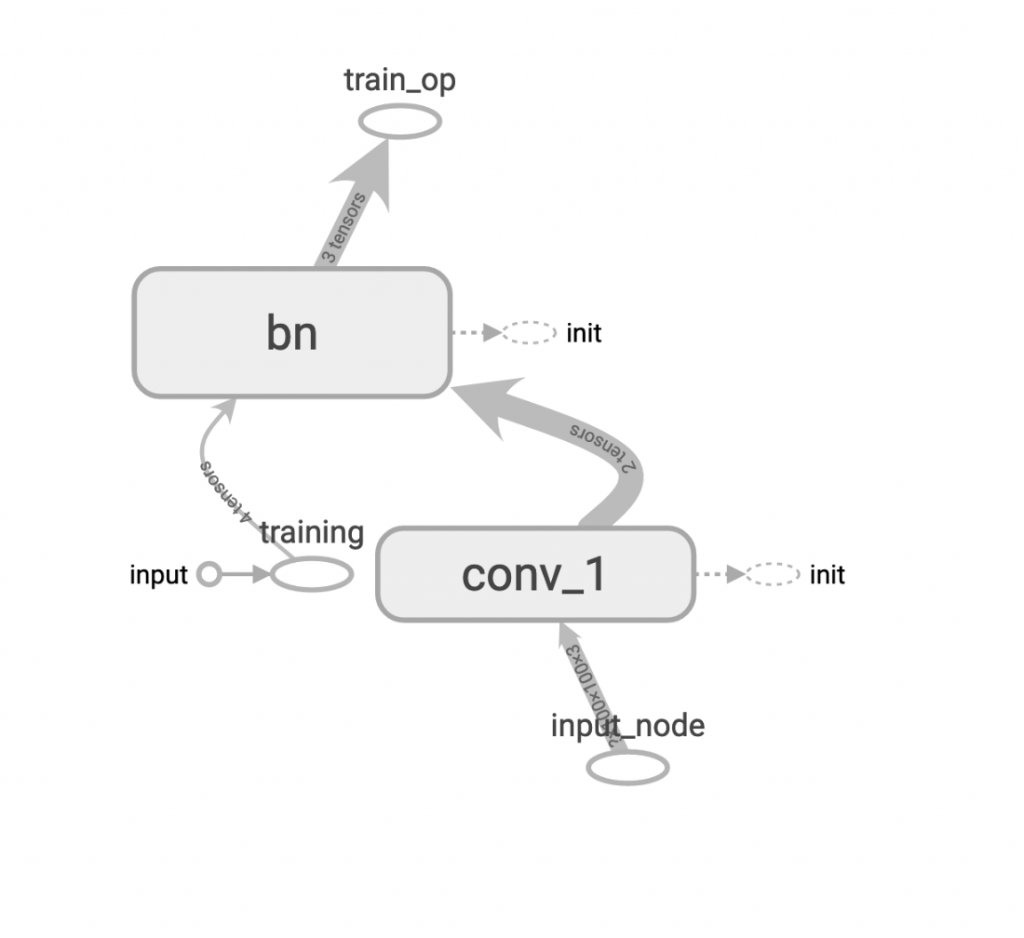今天要介紹的東西,可能很多新手寫錯了都還不知道,包括我早期使用時,大家可以檢視一下自己的模型。
不知道大家還不記得 day10 所介紹的 batch normalization 嗎?當時我示範了在 training_node 為 True 和 False 下會有不同的行為,因此,今天要來詳細介紹,再這兩個不同行為上,到底要如何更新參數!
警告,閱讀這邊文章前,請先確實充分理解 batch normalization 原理,若觀念還很模糊者請先點擊上方 day10 連結複習。
一開始,先建立示範用的模型。
input_node = tf.placeholder(shape=[None, 100, 100, 3], dtype=tf.float32, name='input_node')
training_node = tf.placeholder_with_default(True, (), name='training')
net = tf.layers.conv2d(input_node, 32, (3, 3), strides=(2, 2), padding='same', name='conv_1')
net = tf.layers.batch_normalization(net, training=training_node, name='bn')
視覺化如圖:
再來是 batch normalization 的兩個重要的參數,moving_mean 和 moving_var,我們在這邊取得這兩個 tensor 以便觀察。
moving_mean = tf.get_default_graph().get_tensor_by_name(
"bn/moving_mean/read:0")
moving_var = tf.get_default_graph().get_tensor_by_name(
"bn/moving_variance/read:0")
關鍵的地方到了,既然 moving_mean 和 moving_var 要在training_node=True時計算,那該如何去更新它呢?其實在宣告 tf.layers.batch_normalization 時,tensorflow 會自動把它的 update operation 放進全域的變數區裡,要拿到這個 op,我們可以透過 tf.get_collection 來取得,示範如下。
update_op = tf.get_collection(tf.GraphKeys.UPDATE_OPS)
print(f'update_op: {update_op}')
把 update_op 印出來可以看到:
update_op: [<tf.Operation 'bn/AssignMovingAvg' type=AssignSub>, <tf.Operation 'bn/AssignMovingAvg_1' type=AssignSub>]
那麼,現在我們要在 train_op 執行之前,先執行上面那個 update_op,這就會用到幾天前講到的 control_dependencies 來排定。
with tf.control_dependencies(update_op):
train_op = tf.identity(net, name='train_op')
如此,只要執行一次 train_op,tensorflow 就會先跑 batch normalization 的 update_op。
我們實際run一次結果:
with tf.Session() as sess:
sess.run(tf.global_variables_initializer())
sess.run(tf.local_variables_initializer())
image = cv2.imread('../05/ithome.jpg')
image = np.expand_dims(image, 0)
for _ in range(100):
sess.run(train_op, feed_dict={input_node: image})
result, mm, mv = sess.run([net, moving_mean, moving_var],
feed_dict={input_node: image, training_node: False})
print(f'with_update_op:\n(mm , mv) : ({mm[0]:.2f} , {mv[0]:.2f})\n{result[0, 22:28, 22:28, 0]}')
會印出:
我們看到 moving_mean 和 moving_var 分別是 -6.73 和 82.14,這一定是有經過 update_op 的計算所產生出的結果,另外,也可以看到輸出的數值也很明顯經過 normalization。
那如果沒有先經過 update_op 的 normalization 會長怎樣呢?我們來實驗看看
input_node = tf.placeholder(shape=[None, 100, 100, 3], dtype=tf.float32, name='input_node')
training_node = tf.placeholder_with_default(True, (), name='training')
net = tf.layers.conv2d(input_node, 32, (3, 3), strides=(2, 2), padding='same', name='conv_1')
net = tf.layers.batch_normalization(net, training=training_node, name='bn')
moving_mean = tf.get_default_graph().get_tensor_by_name(
"bn/moving_mean/read:0")
moving_var = tf.get_default_graph().get_tensor_by_name(
"bn/moving_variance/read:0")
train_op = tf.identity(net, name='train_op')
with tf.Session() as sess:
sess.run(tf.global_variables_initializer())
sess.run(tf.local_variables_initializer())
image = cv2.imread('../05/ithome.jpg')
image = np.expand_dims(image, 0)
for _ in range(10):
sess.run(train_op, feed_dict={input_node: image})
result, mm, mv = sess.run([net, moving_mean, moving_var], feed_dict={input_node: image, training_node: False})
print(f'without_update_op:\n(mm , mv) : ({mm[0]:.2f} , {mv[0]:.2f})\n{result[0, 22:28, 22:28, 0]}')
印出:
moving_mean 和 moving_var 分別是 0 和 1,根本沒有更新過,而且輸出的數值也很明顯沒有 normalization...。
希望以上給大家的示範夠詳盡,很多新手如果不清楚這件事的話,竟會發現自己爽開很多 batch normalization layer,結果模型訓練時容易失敗或發生詭異現象,就該注意一下自己有沒有用對喔!

 iThome鐵人賽
iThome鐵人賽
 看影片追技術
看更多
看影片追技術
看更多